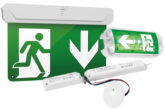
The experts at ROBUS offer some pointers on verifying the quality of the emergency lighting products you’re considering fitting.
You wouldn’t buy the cheapest parachute in the store, so why buy the cheapest emergency lighting? After all, both are designed as life-saving devices!
That said, it’s true that without knowing what to look for, it can be difficult to discern the difference in the quality of emergency lighting. The rule of thumb, “If it looks too good to be true (too cheap!), then it probably is,” will only take you so far.
So, how can you verify the quality of your emergency products?
New Enhanced ICEL Product Certification Scheme
The Lighting Industry Association (LIA) and Industry Committee for Emergency Lighting (ICEL) are making it easier than ever for electricians to identify high-quality lighting products through the enhanced ICEL Product Certification Scheme. This scheme provides independent verification of emergency products, ensuring that certified products meet stringent safety standards.
The rigorous review process consists of different tests and assessments, and for some lighting manufacturers, obtaining this new certification will require a significant investment.
However, for companies that already have high quality standards embedded in the development of their emergency lighting, this will be a simple adjustment. For example, ROBUS has been incorporating the glow wire test into its product development process for years.
What is the glow wire test?
The glow wire test for emergency lighting, outlined by ICEL in alignment with international standards such as IEC 60598-2-22, is a vital safety evaluation. This test assesses the fire resistance of electrical components, focusing on the materials used in emergency lighting systems.
Let’s see why this matters…
Case in point
Imagine a building experiencing an electrical fault that causes wires to overheat. In a worst-case scenario, the heat could cause nearby components to catch fire, potentially leading to a dangerous situation, especially in an emergency.
Now, consider that the building’s emergency lighting system needs to guide people to safety during this event. If the materials used in the emergency lighting system are not fire-resistant, they could ignite or melt, rendering the lights useless (even dangerous) when they’re needed most.
This is where the glow wire test becomes crucial. By ensuring that the components of emergency lighting systems can withstand high temperatures without catching fire, the test helps to prevent such failures.
See the glow wire test in action
Let’s take EBLANA, a popular bulkhead from ROBUS, as an example to understand how the glow wire test works in practice.
For any test or experiment, it is important to ensure standardised conditions for a fair assessment, establish agreed-upon acceptance criteria, and specify the test equipment.
Here’s how this was outlined in the official glow wire test documentation for the ROBUS EBLANA:
Test conditions
Parts are subjected to a test using nickel-chromium glow-wire heated to 850°C. The test apparatus and test procedure shall be those described in IEC 60695-2-11. Any flame or glowing of the sample shall extinguish within 30 seconds of withdrawing the glow wire, and any burning or molten drop shall not ignite the underlying parts specified in IEC 60695-2-11.
Acceptance criteria
Extinguish within 30 seconds and any burning or molten drop shall not ignite the underlying parts.
Test equipment
Once these elements are all in place, the test can begin. The test procedure is as follows:
• Heating the wire: the glow wire is electrically heated to 850°C.
• Application: the heated wire is pressed against the material being tested for a set duration, usually around 30 seconds.
• Observation: the material is monitored for any signs of ignition, how long the flame lasts, and whether any flaming material drips.
Did ROBUS pass the test?
That’s a 100% pass result!
It’s important to note that the French version of EN IEC 60598-1 requires a glow wire test with the wire heated to 850°C for luminaires intended for use in stairwells or horizontal travel paths. This 850°C standard is also recommended as best practice for emergency lighting on escape routes, as outlined in ICEL Schemes and I.S3217.
A trusted mark of quality
The glow wire test is just one part of the ICEL Product Certification Scheme review process. The scheme involves a detailed assessment of both the products and their accompanying technical documentation, ensuring that the manufacturers’ claims are fully validated. It covers a broad range of emergency lighting products, including luminaires, control gears, and batteries.
So, next time you’re stocking up on emergency lighting look out for the ICEL Certification mark – you might just save someone’s life.
Explore the ROBUS emergency lighting range here
Find more industry technical articles here














